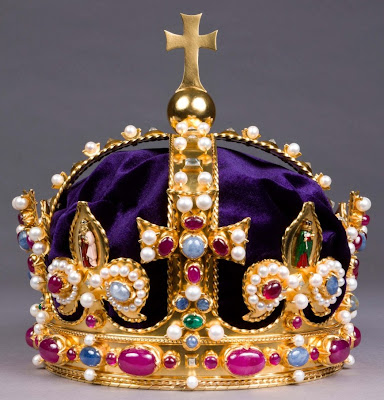The lost crown of HENRY VIII has been recreated in minute detail, down to the last pearl and thumbnail-sized enamelled sculpture, almost four centuries after the royal regalia was destroyed by Cromwell.
The replica will be exhibited at Hampton Court Palace, where the King wore the original crown on great occasions of state and church.
It will be displayed in the royal pew of the Chapel Royal, which re-opens in October, 2012, after seven years of restoration work.
The crown may have been made for the King's father, HENRY VII, and was used in the coronations of his children Edward, Mary and Elizabeth; and then of JAMES I and CHARLES I.
During this period it was a sacred object: a portrait by Daniel Mytens in 1631 ~ now in the National Portrait Gallery ~ and crucial evidence for the historians who pored over every surviving image and account, shows CHARLES I standing bare-headed by a velvet-draped table, on which the crown is shown in scrupulous detail.
In 1649 King Charles I was beheaded outside Whitehall Palace and the crown was broken up at the Tower of London.
The gold went straight to the royal mint for coinage; the jewels were said to have been sold off in mixed packets, like loose sweets.
HENRY VIII's crown is first mentioned as "the kingis crowne of golde", in an inventory of his jewels in 1521.
Historians on the staff of Historic Royal Palaces (HRP), tracked it through later inventories, including the one made after Henry's death in 1547 when every royal cupboard was turned out to record everything from torn bedsheets to the crown and its 344 gems, including "nyne perles not all of one sorte and three Saphires".
The inventories showed how the King remodelled the crown during his reign to reinforce his new role as head of the Church of England, substituting three kings for three small figures of Christ.
Few in the watching crowds could have spotted that at the back of the crown, shown in the Mytens painting, he kept the tiny image of the Virgin and Child.
The materials, costing an undisclosed five-figure sum, were paid for by HRP, and the hundreds of hours of labour, faithfully following Tudor metalworking techniques including use of hand-twisted square gold wire, were donated by Harry Collins, who retired this year as crown jeweller, though remains HM The Queen's personal jeweller.
The gems and pearls in the recreated crown are real; but fortunately for the HRP budget, the Tudors cared more about size and colour than flawless quality.
The only substitute was rock crystal for the huge diamonds and gold-plated silver instead of the original three kilos of solid gold, which would now cost considerably more than a king's ransom.
The recreated crown of HENRY VIII goes on display at Hampton Court Palace from 27 October, 2012.
The replica will be exhibited at Hampton Court Palace, where the King wore the original crown on great occasions of state and church.
It will be displayed in the royal pew of the Chapel Royal, which re-opens in October, 2012, after seven years of restoration work.
The crown may have been made for the King's father, HENRY VII, and was used in the coronations of his children Edward, Mary and Elizabeth; and then of JAMES I and CHARLES I.
During this period it was a sacred object: a portrait by Daniel Mytens in 1631 ~ now in the National Portrait Gallery ~ and crucial evidence for the historians who pored over every surviving image and account, shows CHARLES I standing bare-headed by a velvet-draped table, on which the crown is shown in scrupulous detail.
In 1649 King Charles I was beheaded outside Whitehall Palace and the crown was broken up at the Tower of London.
The gold went straight to the royal mint for coinage; the jewels were said to have been sold off in mixed packets, like loose sweets.
HENRY VIII's crown is first mentioned as "the kingis crowne of golde", in an inventory of his jewels in 1521.
Historians on the staff of Historic Royal Palaces (HRP), tracked it through later inventories, including the one made after Henry's death in 1547 when every royal cupboard was turned out to record everything from torn bedsheets to the crown and its 344 gems, including "nyne perles not all of one sorte and three Saphires".
The inventories showed how the King remodelled the crown during his reign to reinforce his new role as head of the Church of England, substituting three kings for three small figures of Christ.
Few in the watching crowds could have spotted that at the back of the crown, shown in the Mytens painting, he kept the tiny image of the Virgin and Child.
The materials, costing an undisclosed five-figure sum, were paid for by HRP, and the hundreds of hours of labour, faithfully following Tudor metalworking techniques including use of hand-twisted square gold wire, were donated by Harry Collins, who retired this year as crown jeweller, though remains HM The Queen's personal jeweller.
The gems and pearls in the recreated crown are real; but fortunately for the HRP budget, the Tudors cared more about size and colour than flawless quality.
The only substitute was rock crystal for the huge diamonds and gold-plated silver instead of the original three kilos of solid gold, which would now cost considerably more than a king's ransom.
The recreated crown of HENRY VIII goes on display at Hampton Court Palace from 27 October, 2012.















0 comments:
Post a Comment